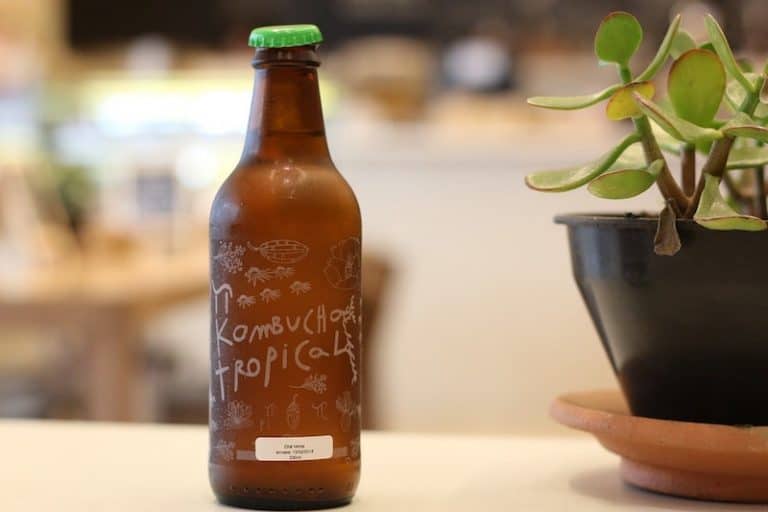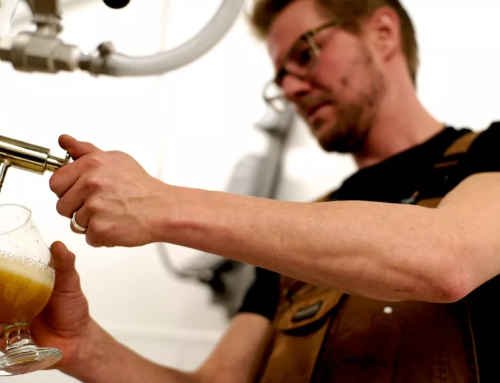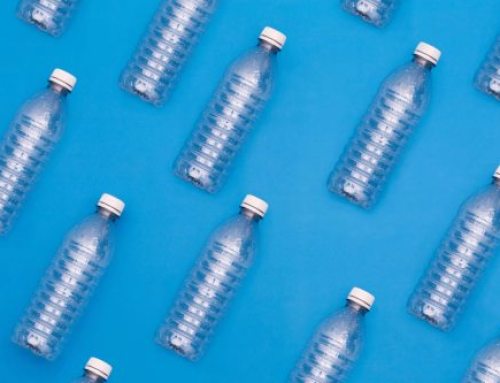Do you ferment your own kombucha at home?
What type of containers did you use to ferment your kombucha?
In glass?
Plastic?
The use of plastic in kombucha fermentation is a bit of a moot point. This is the case if you plan to use it for the second fermentation.
I'll explain here that although technically you can do a second fermentation of kombucha in plastic, it's not recommended.
The main reason is that the chemical reactions that occur during fermentation interact with the plastic, causing harmful chemicals to leach into your kombucha.
First, let's discuss the basics of kombucha fermentation before going into the details of the second fermentation of kombucha in plastic.

Fermentation of kombucha
Kombucha has become a bit fashionable recently. For those of you who are unfamiliar with kombucha and how it's made, we're going to give you a quick overview.
Kombucha is a fermented tea-based product with a tangy flavour and sweet notes.
You can make kombucha at home quite quickly with just a few ingredients.
All you need are tea leaves, sugar, SCOBY (a symbiotic culture of bacteria and yeast), water and the tools for cooking and bottling.
The kombucha fermentation process takes place in two stages.
During the first fermentation, you cover the container lightly so that the fermentation process can take place naturally.
The first fermentation takes at least a week and can last up to a month.
The key to first fermentation is to taste often.
The second fermentation is where it all begins.
This is when you can flavour the kombucha and observe the formation of carbonation.
For the second fermentation, you need to use a hermetically sealed container in which you can consume your drink.
There are several types of container, plastic being one of the easiest and cheapest to obtain.
But can you really use it?
Can kombucha be fermented in plastic containers?
Although you can ferment kombucha in plastic containers, I strongly recommend not using plastic containers for the first fermentation.
This is due to the chemical reactions that occur during fermentation and carbonation.
If you use plastic or other non-food materials, you run the risk of the harmful chemicals contained in plastic (BPA, phthalates, etc.) participating in these chemical reactions and leaching into your drink.
Unlike plastic, glass, food-grade ceramic or stainless steel containers are inert and do not react to the chemical reactions of kombucha.
Another problem with plastic containers is their tendency to scratch.
Large plastic drums may seem ideal for your initial fermentation, but you risk scratching the bucket when you mix your ingredients.
And if you don't disinfect your bucket carefully after scratching it, bacteria can accumulate in the tiny crevices.
Although kombucha is made up of 'good' bacteria, the build-up of bacteria in your first fermentation vessel can have side effects, both for you and for your kombucha.
An excess of bacteria or undesirable bacteria can cause the SCOBY to die and interrupt the fermentation process.
If ingested, the imbalance of bacteria can cause stomach upsets (and more serious problems are possible in some cases).
If you plan to use plastic products to make kombucha, make sure you choose food-grade plastic and avoid scratching or damaging the container.
You should also be prepared for the strong smell of kombucha to stick to the plastic (this is not as much of a problem with glass containers).
Overall, I would certainly consider the harmful effects of plastic during the primary fermentation process discussed here.

Can kombucha be fermented in plastic?
The second fermentation takes place when your kombucha has reached the desired acidity and flavour.
This is when you can add flavourings such as fruit juices, root vegetables or spices to enhance the flavour.
It's also during the second fermentation that you can use plastic bottles much more safely than during the first fermentation. That said, I always prefer glass bottles to minimise the risks.
The main feature you should look for in a secondary fermentation container is a tight-fitting lid.
It's during the second fermentation that you create carbonation, and without a tight-fitting lid, this carbonation will escape.
Plastic and glass bottles are ideal.
Plastic can be used during the second fermentation for two main reasons: fermentation time and acidity.
The second fermentation lasts only two or three days to fix the carbonation and flavours.
The kombucha won't stay in the plastic bottle as long as it did during the first fermentation, so your kombucha won't interact much with the plastic.
Just make sure you consume the kombucha fairly quickly after the second fermentation and try not to re-use the bottle.
The acidity of your kombucha decreases slowly from the first to the second fermentation. During the first fermentation, the acidity is relatively high and can eat away at the plastic.
Many people reuse their first fermentation container.
If you reuse a plastic container, repeated exposure to strong acidity can degrade the plastic and leave behind harmful chemicals.
Once the first fermentation is complete, the acidity of your kombucha has decreased to safe levels, and you can transfer it to food-grade plastic for the second fermentation.
The second fermentation occurs at a much lower acidity and should not degrade the plastic on a one-off basis (the key word being 'one-off').
Councils and alternatives to plastic
One of the most common solutions for replacing plastic in the second closure is the flip-top bottle.
These bottles have a rubber stopper that fits into the neck of the bottle.
The rubber stopper is attached to a pivoting arm that allows the bottle to be opened and closed for easy drinking.
Hinged-lid bottles are ideal for fermenting kombucha because they are made of glass and are designed to be used in one place.
Glass bottles, as mentioned above, are inert and scratch-resistant.
They can therefore be washed and used several times after being properly disinfected.
Single-use bottles are ideal for kombucha, as they retain the carbonation until someone wants to drink.

Glass bottles are another alternative to plastic bottles.
If you're making a large quantity of kombucha and planning to share it with friends, glass jars with a capacity of half a gallon or more are perfect.
Disinfected glass is also ideal for new ferments.
As well as standard glass bottles, containers such as stainless steel water bottles or glass jar-jars are ideal for secondary fermentation.
Stainless steel is relatively resistant to scratches, but you still need to be careful when emptying the bottle.
Mason jars also make excellent kombuchas, but you need to make sure that the cap fits tightly on the jar.
In a nutshell
Kombucha is an incredible drink to make at home, as it requires relatively little effort (but a lot of waiting)!
Once you've got all the ingredients, all you need to make kombucha is the right container.
Now that you know you can use plastic for your second kombucha fermentation if you have no other solution to hand, you're ready to make your favourite drink!









Leave A Comment